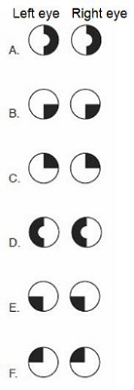Check out today’s Step 1 Qmax Question Challenge.
Know the answer? Post it below! Don’t forget to check back for an update with the correct answer and explanation (we’ll post it in the comments section below).
 A 78-year-old right-handed man with a medical history of two transient ischemic attacks and hypertension presents to his general practitioner complaining that he is having trouble recognizing friends and acquaintances, even his wife. He reports he has had to depend upon mannerisms, clothing, and voices to determine people’s identities. His wife reports that the patient drives slower and adjusts his head position frequently while driving.
A 78-year-old right-handed man with a medical history of two transient ischemic attacks and hypertension presents to his general practitioner complaining that he is having trouble recognizing friends and acquaintances, even his wife. He reports he has had to depend upon mannerisms, clothing, and voices to determine people’s identities. His wife reports that the patient drives slower and adjusts his head position frequently while driving.
Which of the visual disturbances shown in the image is the most likely to occur in this patient?
A. A
B. B
C. C
D. D
E. E
F. F
———————–
Want to know the ‘bottom line?’ Purchase a USMLE-Rx Subscription and get many more features, more questions, and passages from First Aid, including images, references, and other facts relevant to this question.
This practice question is an actual question from the USMLE-Rx Step 1 test bank. For more USMLE Step 1 prep, subscribe to our Flash Facts and Step 1 Express video series. Score the best deal on all three products with a Step 1 Triple Play Bundle.




D
E
A
d PCA infarct of non dominant hemisphere
The correct answer is F. The patient’s medical history of transient ischemic attacks and hypertension puts him at high risk for a stroke. His presentation of prosopagnosia (inability to recognize faces) suggests involvement of the right inferior temporal lobe specifically the right fusiform gyrus, which is in the vascular territory of the inferior division of the middle cerebral artery. Temporal lobe lesions or injuries can cause damage to the lower division of the geniculocalcarine tract, which is known as the Meyer loop. These radiations represent the contralateral superior visual field quadrants. Since the lesion is behind the optic chiasm, the resulting deficit would be a contralateral upper quadrantanopia, which is represented by answer choice F.
A is not correct. Right hemianopia with macular sparing would result from injury to the left visual cortex.
B is not correct. Right lower quadrantanopia would result from injury of the neuronal projections to the superior bank of the calcarine sulcus on the left side, not the right side, because damage in this region results in contralateral lower quadrantanopia.
C is not correct. Right superior quandrantanopia corresponds to the a lesion of the left Meyer loops. This patient’s lesion is on the right and thus inconsistent with the patient’s presentation.
D is not correct. Left hemianopia with macular sparing would result from injury to the right visual cortex, which is located on the banks of the calcarine fissure.
E is not correct. Left lower quadrantanopia would result from injury to the neuronal radiations projecting to the superior bank of the calcarine sulcus.
Thank you for explanation . Now is clear .
A case of a prosopagnosia is “Dr. P.” in Oliver Sacks’ 1985 book The Man Who Mistook His Wife for a Hat, though this is more properly considered to be one of a more general visual agnosia. Although Dr. P. could not recognize his wife from her face, he was able to recognize her by her voice. His recognition of pictures of his family and friends appeared to be based on highly specific features, such as his brother’s square jaw and big teeth. Coincidentally, Oliver Sacks himself suffered from prosopagnosia, but did not know it for much of his life.[